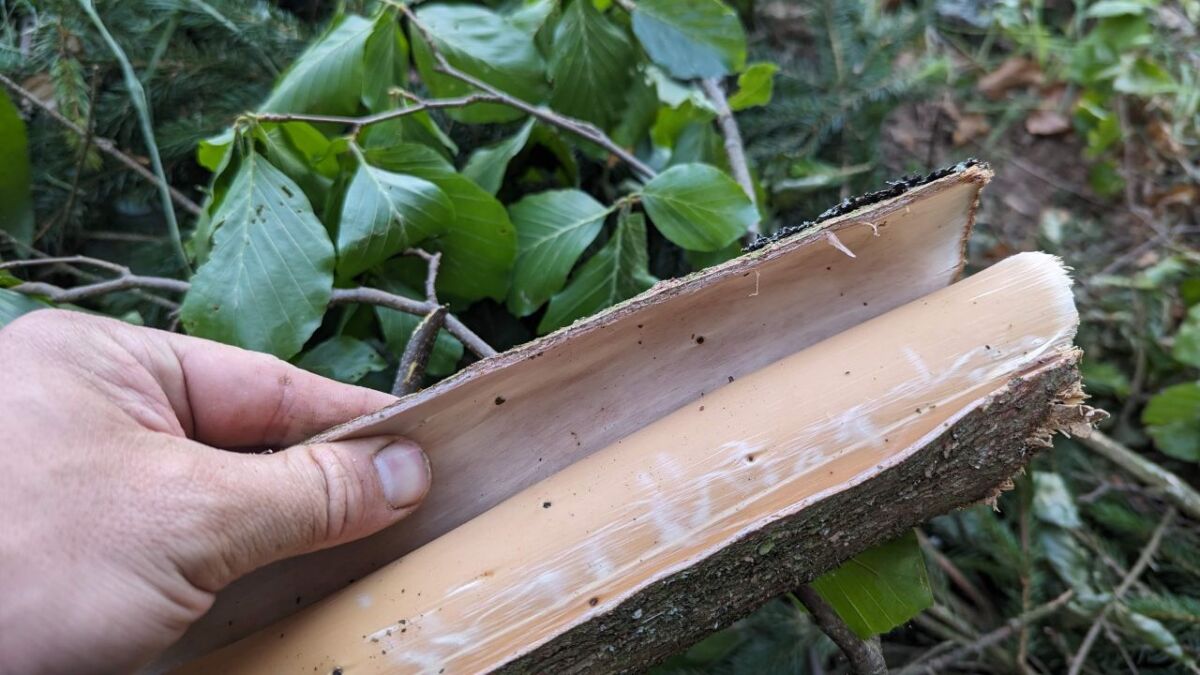
bark
Noun
Meaning
Bark is the protective outer layer of a tree's trunk and branches. In the context of survival, bushcraft, and outdoor activities, bark has several important uses. It can be stripped from trees and used as a natural material for making shelters, such as lean-tos or debris huts. Bark can also be used as a fire starter, as it is highly flammable and can be easily ignited with a spark or flame. Additionally, certain types of bark, such as birch bark, can be used to make containers, like baskets or water vessels, due to their flexibility and waterproof properties.

Examples
„I love using bark as a natural fire starter when I go camping. It's easy to find and it burns really well.“
„During my last survival trip, I used strips of bark to create a makeshift shelter. It provided excellent insulation and kept me dry throughout the night.“
„When foraging for food in the wilderness, I often look for trees with edible bark. Birch bark, for example, can be boiled and eaten as a nutritious snack.“
„One of the most important skills in bushcraft is being able to identify different types of bark. It can give you valuable information about the tree species and its potential uses.“
„In a survival situation, bark can also be used as a natural cordage. By stripping it into thin strips and twisting them together, you can create a strong and durable rope.“
Origin
The word "bark" originates from the Old Norse word "bǫrkr" which means "bark" or "rind". It has its roots in the Proto-Germanic word "barkuz" which also means "bark". The word has been used to refer to the outer protective covering of trees since ancient times.
Throughout history, bark has been utilized by humans for various purposes. In ancient times, indigenous cultures used bark for making shelters, clothing, and containers. The inner bark of certain trees, such as the slippery elm, was used for medicinal purposes due to its soothing properties.
In the context of survival and bushcraft, bark is a valuable resource. It can be used for making cordage, containers, and even shelters. The fibrous nature of bark makes it ideal for weaving and lashing. Additionally, certain types of bark, such as birch bark, are highly flammable and can be used as tinder for starting fires.
Over time, the knowledge and techniques for working with bark have been passed down through generations. Today, bark is still an important material in the world of wilderness skills and survival. Its versatility and abundance in nature make it a valuable resource for those who seek to live in harmony with the natural environment.
Synonyms
Bark, Tree skin, Outer layer, Rind, Cortex, Periderm, Bast, Phloem
Antonyms
Wood, Silence, Smooth, Interior, Flesh, Quiet, Whisper, Soft
Relatives
Tree, Wood, Forest, Bark stripping, Bark beetle, Bark canoe, Bark cloth, Bark mulch
Historical and cultural importance
The word "bark" has a rich historical and cultural significance, especially in the context of survival and bushcraft. In ancient times, bark played a crucial role in the lives of indigenous peoples and early settlers, providing them with essential materials for shelter, clothing, and tools.
Throughout history, various cultures around the world have utilized bark in different ways. For example, Native American tribes in North America used bark from trees like birch and cedar to construct lightweight and durable shelters, such as wigwams and longhouses. The inner bark of certain trees was also used for making clothing, baskets, and even canoes.
In Scandinavian countries, the tradition of using bark for survival purposes has been passed down through generations. The Sami people, who inhabit the northern regions of Norway, Sweden, Finland, and Russia, have long relied on the bark of the birch tree for making traditional footwear, known as "gákti," which is still worn today during special occasions and cultural events.
Furthermore, the process of extracting bark from trees and utilizing it for various purposes has been an integral part of the wilderness skills and knowledge passed down by bushcraft enthusiasts. Learning how to properly harvest bark without harming the tree and then using it to create containers, cordage, or fire-starting materials is a fundamental skill in survival scenarios.
Overall, the historical and cultural relevance of bark highlights its importance as a versatile and sustainable resource in the realm of survival and bushcraft.
More information about the term bark
What is Bark?
Bark is the protective outer layer of a tree's trunk and branches. It serves as a shield, defending the tree against external elements such as extreme temperatures, insects, and diseases. The bark is made up of several layers, each with its own unique characteristics and functions.
Types of Bark
There are different types of bark, each with its own distinct appearance and texture. Some common types of bark include:
1. Smooth Bark: This type of bark is often found on young trees and has a sleek, even texture. It provides a smooth surface for the tree's growth and expansion.
2. Rough Bark: Rough bark is typically found on older trees and has a more rugged and uneven texture. It offers better protection against external threats and helps the tree withstand harsh weather conditions.
3. Peeling Bark: Some trees, such as birch and paperbark maple, have bark that peels off in thin layers. This characteristic allows the tree to shed damaged or diseased bark, promoting healthy growth.
4. Corky Bark: Corky bark is thick and spongy, providing excellent insulation for the tree. It is commonly found on trees in colder climates, helping them retain heat and survive freezing temperatures.
Uses of Bark
Bark has been utilized by humans for various purposes throughout history. Here are some common uses of bark:
1. Traditional Medicine: Many cultures have used tree bark for its medicinal properties. Certain barks contain compounds that have been found to have anti-inflammatory, analgesic, and antimicrobial effects.
2. Natural Dyes: Some barks, such as oak and willow, can be used to extract natural dyes. These dyes have been used for centuries to color fabrics and materials.
3. Fire Starting: Dry bark can be an excellent source of tinder for starting fires. Its fibrous nature makes it easy to ignite, providing a reliable source of heat and light in survival situations.
4. Crafts and Art: Bark can be used in various craft projects and artwork. It can be shaped, carved, or woven to create baskets, masks, and other decorative items.
Conclusion
Bark is a vital part of a tree's anatomy, providing protection and support. Its different types and characteristics make it a versatile material with various practical and cultural uses. Whether you're exploring the wilderness or engaging in traditional crafts, understanding the properties of bark can enhance your survival skills and appreciation for nature.
Back to overview

